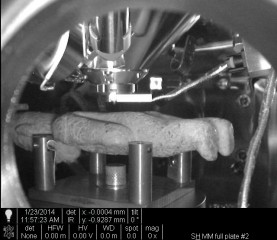Nov 12 2014
Geologist Timothy Rose of the Smithsonian Institution’s Analytical Laboratories is accustomed to putting his lab’s high-tech nanoscale scanning electron microscope (nanoSEM) to work evaluating the mineral composition of rocks and meteorites. Lately, though, the nanoSEM has been enlisted for a different kind of task: determining the authenticity of ancient Mesoamerican artifacts.
 A 17 cm carved stone figurine shown inside the SEM chamber ready for non-destructive imaging and analysis. (T. Rose/Smithsonian)
A 17 cm carved stone figurine shown inside the SEM chamber ready for non-destructive imaging and analysis. (T. Rose/Smithsonian)
In ongoing studies, Rose and his colleague Jane Walsh have now analyzed hundreds of artifacts, including carved stone figurines and masks and ceramic pieces from the ancient Olmec, Maya, Teotihuacan and Mezcala civilizations dating from 1500 B.C. to A.D. 600. “With our modern imaging and analytical tools we can look at objects at very high magnification, which can reveal new details about how, and sometimes when, objects were created,” he said.
Rose will discuss the technology at the AVS 61th International Symposium and Exhibition, to be held Nov. 9-14, at the Baltimore Convention Center in Baltimore, Md.
The nanoSEM used by Rose and his colleagues has the ability to function over a range of pressures. “Being able to work in the low-vacuum mode allows us to put samples into the microscope au naturel without coating them with an electrically conductive material such as carbon, which would be almost impossible to remove from a specimen,” he said.
In one study, Rose and colleagues used the nanoSEM to study stone masks from Teotihuacan, a pre-Columbian site located 30 miles northwest of Mexico City. The masks, about the size of a human face, were too big to be put into the device (and, more importantly, could not be removed from their respective museums or drilled or otherwise altered to obtain samples for analysis). However, silicone molds that were made of the objects to study tool marks with an optical microscope did remove tiny mineral grains from deep within cracks and drill holes. Chemical evaluation of these grains using the nanoSEM’s X-ray spectrographic analysis system showed that some were diatoms—common single-celled algae with cell walls made of silica. Diatomaceous earth is “a very fine powdery siliceous rock comprised entirely of diatoms that would make very nice polish for the stone of these specific masks,” Rose said. “We believe we found abrasive grains and polish that was used in the manufacturing process.”
In a separate study of artifacts confiscated by the federal government, the researchers found some pieces to be partially coated with a layer of what looked to be modern gypsum plaster. In other words, the pieces were fakes. However, Rose noted, a surprisingly small percentage of the objects evaluated to date have shown modern tools marks or other evidence of recent origins. One unique ceramic handled pot analyzed in detail, for example, had five chemically distinct layers that appeared to be original Olmec fresco paint—a level of craftsmanship that, he said, is unlikely to have been the work of modern artisans.